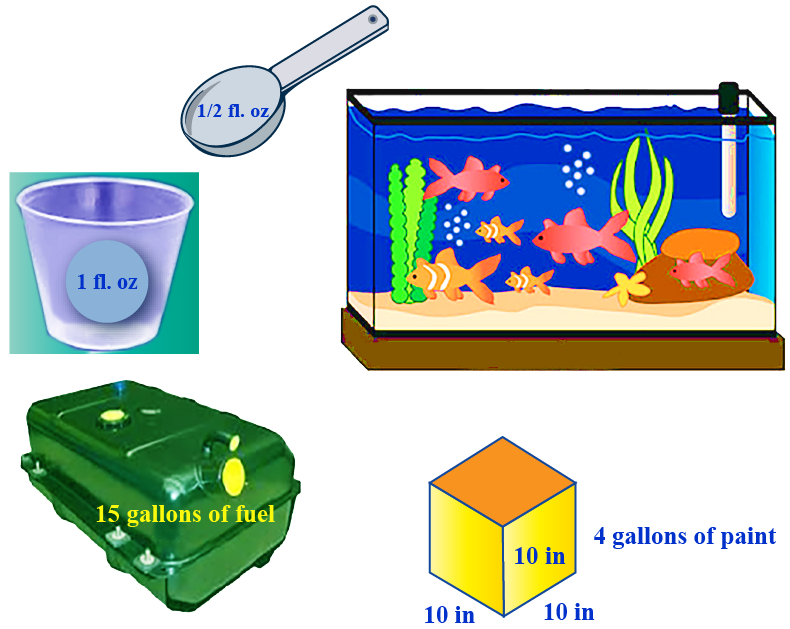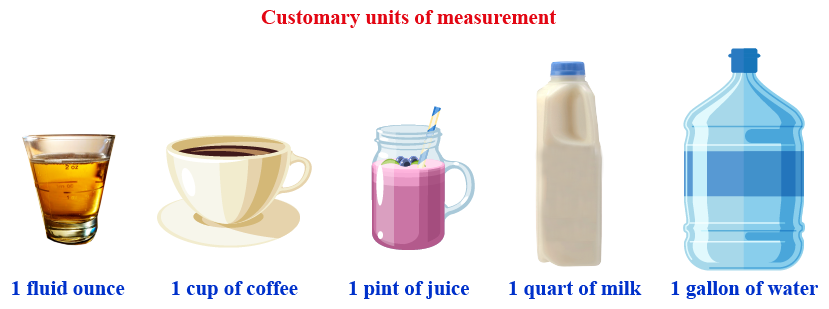Measuring Capacity
We use spoons, jugs, glasses, beakers, bowls, barrels, bottles, pitchers, cartons, cans, and the like to store liquids.
We take medicine in a fluid ounce.
The capacity of a tablespoon is nearly half a fluid oz.
The capacity of 25 teaspoons is nearly equal to half a cup.
The capacity of a car's fuel tank is about 15 gallons. A fish tank can hold 6 gallons.
A \(10 x 10 x 10\) inch carton cube can hold 4 gallons of paint.
How do we measure them?
Capacity is the amount of liquid that a container can hold.

In this mini-lesson, let us learn about measuring capacity, measure of capacity, the unit of capacity, measure capacity worksheet, and measurement capacity.
Lesson Plan
What Is Capacity Measurement?
Capacity
The term capacity is used for measuring the volume of a liquid.
The amount of liquid that any container can hold is called its capacity.
Capacity Measurement
The American metric system is also called the United States Customary Units (USCS).
USCS follows 5 customary units to measure the capacity.

How to Measure Capacity?
To get the idea to measure capacity, we need to know the objects that hold liquids around us.
| Units of capacity | Example |
|---|---|
| Fluid ounce | syrup or tonic |
| Cup | coffee or tea |
| Pint | juice jar |
| Quart | milk carton or water jar |
| Gallon | petrol or gasoline |
Estimation
Let's find what most likely could be used for the capacity measurement by mere estimation.
| Capacity | Units | Estimation |
|---|---|---|
| A perfume spray can hold | gallons / pints | pints |
| An eyedropper is closer to | a cup / a quart | cup |
| A mop bucket has | gallons / pints | gallons |
| A tea kettle holds in | cups / gallons | cups |
| A water pool measured in | quarts / gallons | gallons |
| A mayonnaise jar | quarts / pints | pints |
Units of Capacity
There are 5 customary units to measure capacity.
A fluid ounce is the smallest unit of measuring capacity and the gallon is the largest unit.
| 1 cup = 8 fl. oz |
Gallon Chart
Use this gallon chart to make the conversions of customary units.
This gallon chart shows us that 1 gallon = 4 quarts = 8 pints = 16 cups.
Capacity Conversion
You can multiply or divide according to the known unit and the required unit.
For Example:
1. \(4 \text{ quarts} = \text{____ pints }\)
From the chart we know that
\[\begin{align}1 \text{ quart} &= 2 \text{ pints}\\4 \text{ quarts} &= 4\times 2 \text{ pints}\\ &= 8 \text{ pints}\end{align}\]
2. \(6 \text{ pints} = \text{_____ quarts}\)
From the chart, we know that
\[\begin{align}1 \text{ pint} &= \dfrac{1}{2} \text{ quart}\\\\6 \text{ pints} &= 6\div 2 \\\\&= 3 \text{ quarts}\end{align}\]
| 8 fl oz | 1 cup |
| 16 fl oz | 1 pint |
| 32 fl oz | 1 quart |
| 128 fl oz | 1 gallon |

- What could be the capacity of an Olympic-size swimming pool?
- Ron has 3 cups with him. If he has 4 pints of coffee in a cup, how can he distribute them evenly in 3 cups?
Measure Capacity
Measuring Capacity Example
Sophie made 8 quarts of orange juice. She divided it into an equal number of cups. How many cups would she have used?
From the gallon chart, we understand that 4 quarts = 16 cups
Thus 8 quarts of juice will be divided into 32 cups.
\(\therefore\) she has used 32 cups to pour the orange juice.
Comparing Capacity Example
A tall glass can hold 4 pints and a big mug can hold 50 fluid oz. Which one holds more?
We know that 4 pints = 8 cups
and 8 fl. oz = 1 cup.
\[\begin{align} 50 \text { fl. oz} &= \dfrac{1}{8}\times 50\\&= 6 \dfrac{1}{4} \text{ cups}\end{align}\]
Thus on comparison we find that
\[8 \text{ cups} > 6 \dfrac{1}{4} \text{ cups}\]
\(\therefore\) the tall glass holds more.
Measurement Capacity
Try solving the simulation below. Adjust the slider to measure the desired amount of gallon.
Click on the measuring beakers and verify how many beakers would you use to fill the gallon jar.

- The capacity or volume is measured using fluid ounce, cup, pint, quart, and gallon.
- Using the gallon chart makes the conversion easier.
Solved Examples
| Example 1 |
The physician prescribed Charlie to take half-fl. oz of medicine twice a day for 4 days. How many cups would he have taken in 4 days?
Solution
In a day he has to take
\((2\times \dfrac{1}{2}) \text{ fl.oz} = 1 \text{ fluid oz per day}\)
In 4 days he would have taken:
\(4\times 1 = 4 \text{ fluid oz. per day}\)
We know that
\[\begin{align}8 \text{ fl.oz} &= 1 \text{ cup}\\4 \text{ fl.oz} &= \dfrac{4}{8} \text{cup} \\&= \dfrac{1}{2}\end{align}\]
| \(\therefore\)Charlie would have taken\(\dfrac{1}{2}\) a cup of medicine in 4 days. |
| Example 2 |
Tom buys 3 gallons of paint and uses 2 quarts to paint the walls in the living room and 3 quarts to paint his garden fence. How much paint is he left with?
Solution
| 1 gallon = 4 quarts |
3 gallons = 12 quarts
After painting the wall, the remaining paint:
\(= 12 - 2 = 10\) quarts.
After painting the fence, the remaining paint:
\(= 10 -3 = 7\) quarts.
| \(\therefore\) The left over paint = 7 quarts. |
| Example 3 |
John consumes 20 cups of water in the first 2 days of a week. Going at the same rate, how many quarts would he have consumed at the end of the week?

Solution
| 1 quart = 4 cups |
If 4 cups = 1 quart then
20 cups \(= 20 \div 4 = 5\) quarts
In 2 days, he consumed 5 quarts.
Then in 7 days he consumed: \[\begin{align}\\&= \dfrac{5}{2} \times 7\\ &= \dfrac{35}{2} \\&= 17\dfrac{1}{2}\text{ quarts}\end{align}\]
| \(\therefore\) John would have consumed \(17\dfrac{1}{2}\) quarts of water. |
Interactive Questions
Here are a few activities for you to practice. Select/Type your answer and click the "Check Answer" button to see the result.
Let's Summarize
The mini-lesson targeted the fascinating concept of measuring capacity. The math journey around measuring starts with what a student already knows, and goes on to creatively crafting a fresh concept in the young minds. Done in a way that not only it is relatable and easy to grasp, but also will stay with them forever. Here lies the magic with Cuemath.
About Cuemath
At Cuemath, our team of math experts is dedicated to making learning fun for our favorite readers, the students!
Through an interactive and engaging learning-teaching-learning approach, the teachers explore all angles of a topic.
Be it worksheets, online classes, doubt sessions, or any other form of relation, it’s the logical thinking and smart learning approach that we, at Cuemath, believe in.
Frequently Asked Questions (FAQs)
1. What units do we use to measure capacity?
We use the 5 main customary units: fluid ounce, cups, pint, quart, and gallon.
2. What does capacity measure?
Capacity measures the amount of liquid occupied by the container it holds.
3. What is capacity measured in?
Capacity is measured in 5 customary units. fluid ounce, cups, pint, quart, and gallon.
4. Which measurement best describes the capacity of a kitchen sink?
A kitchen sink is reasonably measured in gallons.
- Live one on one classroom and doubt clearing
- Practice worksheets in and after class for conceptual clarity
- Personalized curriculum to keep up with school

